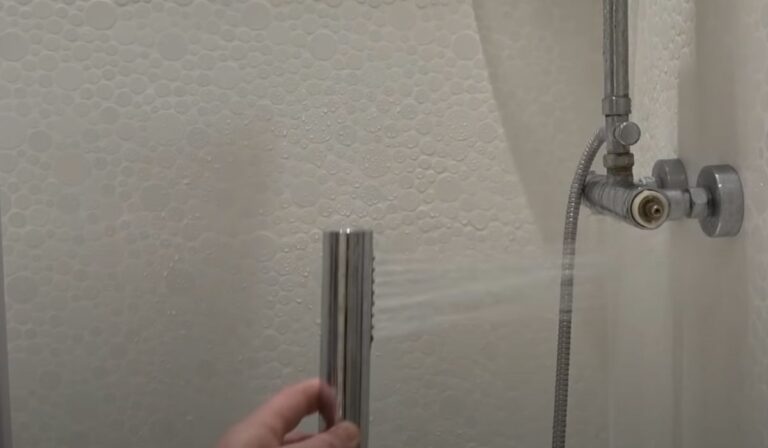What Is a Shower Cartridge
A shower cartridge is the part inside your shower handle that controls water flow and temperature. When you turn the handle, it adjusts how much hot and cold water mix, ensuring your shower stays comfortable and safe. If it wears out, you might notice leaks, inconsistent temperatures, or trouble turning the handle. Understanding how it works and recognizing signs of problems can help you fix or maintain it properly. Keep exploring to find out more useful tips and replacement steps.
How a Shower Cartridge Works
Although it may seem like a small component, the shower cartridge plays a crucial role in controlling water flow and temperature. When you turn the handle, the cartridge moves to adjust the mix of hot and cold water entering the showerhead.
Inside, it contains valves or discs that open and close precisely, allowing the right amount of water through. This mechanism ensures you get the temperature you want without sudden changes.
By regulating pressure and flow, the cartridge maintains a consistent shower experience. If you understand how it works, you’ll appreciate why it’s essential to keep it in good condition.
Proper function means your shower stays comfortable, efficient, and safe every time you step in.
Common Signs of a Faulty Shower Cartridge
When your shower cartridge starts to fail, you’ll notice changes that affect your water flow and temperature control. Water might drip continuously from your showerhead even when the faucet is off, signaling a worn-out cartridge seal. You could also experience inconsistent water temperatures, where the hot and cold mix isn’t steady, making your shower uncomfortable.
If you find it hard to turn the handle or it feels stiff, that’s another common sign. Sometimes, water pressure drops noticeably or the handle leaks water. Ignoring these signs can lead to bigger plumbing issues and higher water bills.
Spotting these problems early helps you decide whether to repair or replace the cartridge, keeping your shower functioning smoothly.
Different Types of Shower Cartridges
Since shower cartridges play a crucial role in controlling water flow and temperature, choosing the right type can make a big difference in your shower experience. You’ll typically encounter three main types: compression, cartridge, and pressure-balancing valves.
Compression cartridges use separate handles for hot and cold water, giving you precise control, but they wear out faster.
Cartridge valves have a single handle that moves up and down or side to side, making them easier to adjust and maintain.
Pressure-balancing cartridges automatically adjust water pressure to prevent sudden temperature changes, which means you won’t get scalded if someone flushes a toilet elsewhere in your home.
Knowing these types helps you pick the best fit for your shower, ensuring comfort and reliability every time you step in.
Steps to Replace a Shower Cartridge
If you notice leaks or inconsistent water temperature, it’s time to replace your shower cartridge. First, turn off the water supply to avoid any mess.
Next, remove the handle by loosening the screw with an Allen wrench or screwdriver.
Take off the trim plate to expose the cartridge.
Use pliers or a cartridge puller to carefully remove the old cartridge.
Before installing the new one, clean the valve body to remove any debris.
Insert the new cartridge, aligning it properly with the notches.
Secure it in place with the retaining clip or nut.
Reattach the trim plate and handle, then turn the water back on.
Test the shower to ensure the new cartridge works smoothly with no leaks.
Tips for Maintaining Your Shower Cartridge
To keep your shower cartridge functioning smoothly, you should perform regular maintenance that prevents buildup and wear. Start by cleaning the cartridge area with a mixture of vinegar and water every few months to dissolve mineral deposits. Avoid using harsh chemicals that can damage the cartridge’s seals.
Check for leaks or drips regularly; even small leaks can cause damage over time. If you notice reduced water flow or difficulty adjusting the handle, it may be time to inspect the cartridge for debris or wear.
Lubricate the cartridge seals with a plumber-approved silicone grease to ensure smooth operation. Lastly, if your water is hard, consider installing a water softener to extend the cartridge’s life. These simple steps will keep your shower working efficiently longer.
Frequently Asked Questions
Can I Use a Universal Shower Cartridge for Any Shower Model?
You can’t always use a universal shower cartridge for any model. Compatibility depends on your shower’s design and size, so check specifications carefully to ensure a proper fit and avoid leaks or malfunction before buying one.
How Long Does a Typical Shower Cartridge Last?
Typically, your shower cartridge lasts about 6 to 10 years, depending on water quality and usage. If you notice leaks or temperature issues, it’s probably time to replace it to keep your shower working smoothly.
Are Shower Cartridges Environmentally Friendly?
Shower cartridges aren’t inherently environmentally friendly, but you can choose ones made from sustainable materials or with water-saving features. Using quality cartridges helps prevent leaks, reducing water waste and supporting eco-friendly bathroom habits.
Do Shower Cartridges Affect Water Pressure?
Yes, shower cartridges can affect water pressure. If your cartridge is clogged or worn out, it may reduce flow. Replacing or cleaning it helps maintain strong, consistent water pressure during your showers.
Can a Shower Cartridge Help Save Hot Water?
Yes, a shower cartridge can help save hot water by regulating temperature more efficiently and preventing unnecessary hot water flow. You’ll notice less waste and better control, which means lower energy bills and more comfort.
Conclusion
Now that you know how a shower cartridge works and the signs of a faulty one, you’re better equipped to keep your shower flowing smoothly. Whether you’re dealing with leaks or temperature issues, understanding different cartridge types helps you choose the right replacement. Follow the steps carefully when replacing it, and don’t forget regular maintenance to extend its life. Taking these simple actions will save you time, money, and frustration in the long run.

